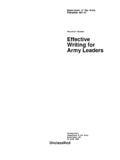Transcription of Become an outstanding briefer. These concise steps tell ...
1 Armed Forces Comptroller Spring 2007 | Briefings are the most common kind of oral presentation in both military and business settings. Sometimes their purpose is to inform to tell listeners about a mission, project, operation, or concept. At other times, briefings are used to train listeners so they can perform a procedure or carry out instructions. Briefings also can advocate or seek to persuade listeners to accept a certain solution or way of doing things. The ABCs of briefing help us remember that a briefing should always be Accurate, Brief, and clear . 1 The good news is almost anyone can Become an outstanding briefer; the disturbing news is most never do. What is the biggest cause of briefing failure? Briefers forget that effective communication is always receiver-centered. It s not about what you want to tell your listeners; rather, it s about what you want them to think, feel, or do.
2 Keeping that thought in mind, here is how to give winning briefings ones that communicate and get desired results. John A. Kline, PhDBecome an outstanding briefer. These concise steps tell you THE B RIEFINGC lear, logical organization is vital to effective briefing, for it serves as the framework or skeleton for effective communication. Good organization for a briefing has three parts: the begin-ning, the body, and the BeginningThe beginning of a briefing is where you tell them what you are going to tell them. Most briefings have a standard beginning. For example, if I were briefing on how to give winning briefings, I most likely would begin by stating my name, title, subject, and main points of the briefing: Good morning, I m Dr. John Kline, director of the Institute for Lead-ership Development at Troy University. Today I will brief you on how to give win-ning briefings.
3 More specifically, we will look at three things: how to organize a briefing, how to support a briefing, and how to deliver a briefing. It is at this point, if applicable, where I would an-nounce the classification of the briefing (confidential, secret, etc.).The Body The body of the briefing is where you tell them. Before you decide on the points you will present in the body, write an objective to guide your preparation. Your objective tells the specific response (or outcome) you want from your audi-ence. Frame your objective this way: The objective of this briefing is for each listener to.. Beginning your objective with this statement helps you focus on the response you hope to achieve from your listeners. It keeps you receiver-cen-tered. For example, the objective of this article is for each reader to know how to give winning briefings. While my task is to tell how to give winning briefings, my objective is for each reader to be able to give , choose main points that will en-able you to meet your objective.
4 For briefings, main points most often are organized chronologically (before/during/after), spatially (north/south/east/west), cause-effect (increased oper-ating tempo/equipment breakdowns), problem-solution (late payments/way to correct the problem), pro-con (stay the course/withdraw), or topically (or-ganize/support/deliver). Notice that even though I used a topical organiza-tion for this article, I am addressing the main points in a specified order one that helps me present the information and, above all, one that helps readers understand and retain the informa-tion for their use. Notice also that the main points of organize/support/deliver clearly support my audience-centered objective: for each reader to know how to give winning briefings. It s what you need to do to conduct an effective EndingThe ending of the briefing is where you tell them what you told them. Most briefings have a standard ending.
5 To end a briefing on how to give winning briefings, I might say: Today I ve discussed how to give winning brief-ings. We looked at three things: how to organize a briefing, how to sup-port a briefing, and how to deliver a briefing. This is followed by a closing statement such as: Thank you for listening; this concludes my briefing. Are there any (further) questions? (Note: If you took questions during the briefing, then clarify by adding the word further. )SUPPORT THE B RIEFINGW hile clear , logical organization pro-vides an effective skeleton for the briefing, supporting material puts flesh on the bones. Supporting ma-terial may be either verbal or visual but, in either case, make certain this material fits both the content and the audience. A briefing is not the place to tell a cute story or use a fancy visual prop or slide that calls attention to it-self. Since briefings are by definition brief, support generally is limited to data carefully selected to accomplish the need to SupportEach of the standard forms of verbal support is important.
6 Definitions are often needed to explain new or unfa-miliar terms or acronyms. Examples provide specific or concrete instances that help clarify general or abstract ideas. Comparisons and contrasts between the familiar and unfamiliar help audiences more readily grasp new ideas. Statistics and testimony (o r q u o t a t i o n s) f r o m e x p e r t a n d trustworthy sources supply factual data and proof for the points you are making. Choose support that fits your audience. Especially use examples and comparisons that are familiar or easily Support Somebody once said a picture is worth a thousand words. Visual aids can dra-matize, amplify, or clarify the points you are trying to get across to your audience. Often, you will use PowerPoint slides to enhance your briefings. But whatever visual support you use, keep a few things in mind. Make sure your visuals are relevant, simple, and large enough to be seen by your audience.
7 And don t let your visuals draw your attention or the attention of the audience away from the THE B RIEFINGA lthough preparing the briefing can be laborious, delivery is the most difficult part for many people but it needn t be. If you know your subject and have prepared well, then presenting brief-ings can be an exhilarating experience. The secret is to be well organized, have the right supporting informa-tion, and then practice, practice, practice giving attention to several important factors of delivery. | Armed Forces Comptroller Spring 2007 Armed Forces Comptroller Spring 2007 | MethodWhile some briefings are read such as mis-sion briefings that must be in sync with slides and/or video clips most briefings should be delivered in an extemporaneous manner. Plan your briefings idea by idea rather than word by word. Then you need only to carry a brief outline or a few notes to the lectern when you speak.
8 This method will require that you prepare carefully, yet it will enable you to adjust to your audience and to sound more spontaneous and ContactEye contact is one of the most important tools at a briefer s disposal. Nothing enhances de-livery more than effective eye contact with the audience. To achieve genuine eye contact, you must do more than merely look in the direction of the audience. The old advice of looking over the tops of your listeners heads or attempting to look at all parts of the audi-ence systematically simply does not describe effective eye contact. You should look directly at people, most likely giving more attention to the senior-ranking person(s) in the audience but attempting to include all listeners. Effective eye contact the kind where you look at lis-teners as you would during a conversation with one or two people will keep the audience s interest, allow you to adjust to nonverbal feed-back, and make you appear more credible to your MovementIn many speaking situations, persons are ad-vised to get out from behind the lectern and move around.
9 With briefings, however, this often is not possible; briefings typically are presented from behind a lectern. If you are using a lectern, be careful not to lean or rock on it or sway out of the range of the micro-phone (if you are using one). If possible, ad-just the lectern to a comfortable height one that allows you to place your hands comfort-ably on the surface to handle your notes or to gesture them. The hands, arms, shoulders, head, and face can help to reinforce what you are saying. Although gestures can be perfected with practice, they will be most ef-fective if you make a conscious effort to have them appear natural and spontaneous rather than planned. If possible, video-record one of your briefings so you can observe your-self and decide which gestures are effective and whether they reinforce the spoken mes-sage. And remember, a comfortable smile (not a silly grin or nervous laughter) helps most briefings, warms your audience to your presentation, and makes you appear more confident and vocal characteris-tics are important.
10 The first is quality. Although you should strive to produce a pleasing tone and at-tempt to use your voice to its best advantage, rest easy i n k n o w i n g t h a t some of the very finest briefers have only average second is understandability. Your audi-ence must be able to understand you. Give special attention to articulation (how you form sounds), pronunciation (how you say words), and avoidance of stock expressions (such as okay or vocalized pauses such as uh, um, or and uh ). Above all, avoid poor grammar; it affects understandability and re-flects negatively on you and your third characteristic is variety. Effective briefers vary the rate, volume, force, pitch, and emphasis. As with everything else, con-sider your audience. Your primary task is not to deliver information; it is to help the audi-ence mark of effective delivery is how well the parts are tied together.





